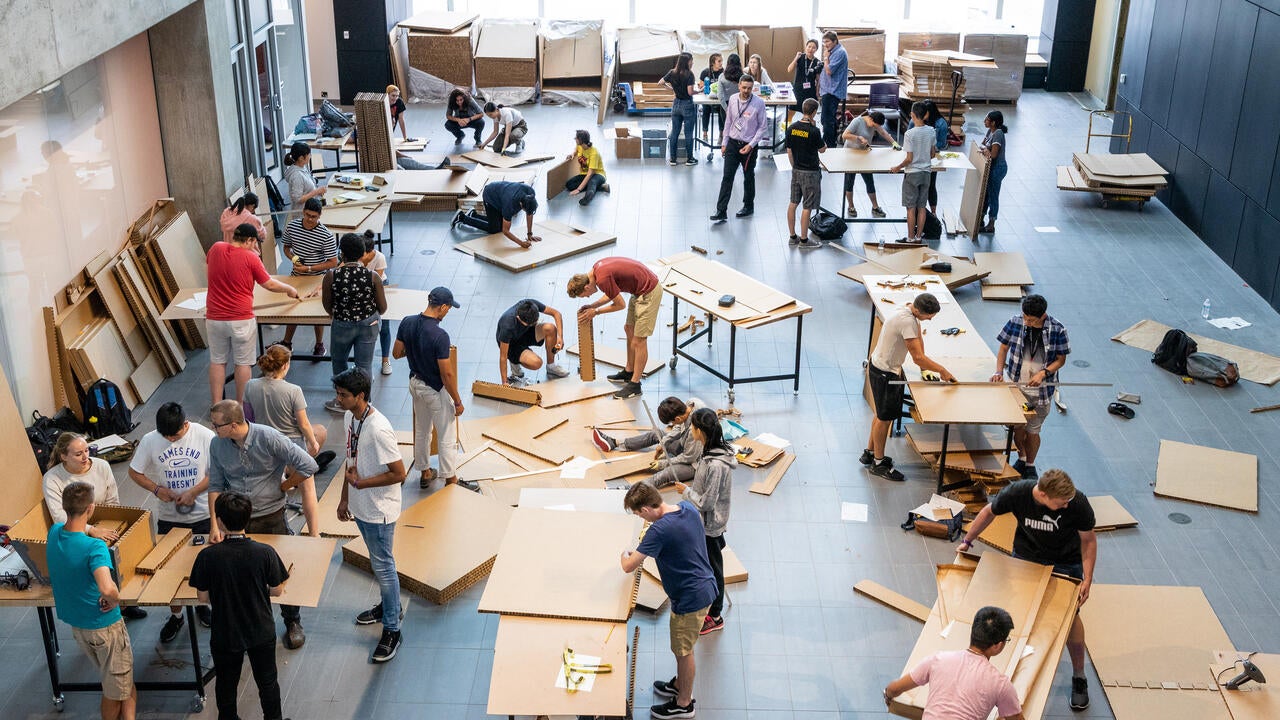
Hands-on projects set the tone of new program
First class of architectural engineering is learning by designing and building

First class of architectural engineering is learning by designing and building
The first 91 students in the newest undergraduate program at Waterloo Engineering didn’t waste any time before getting their hands dirty as the fall term began in September.
Instead of settling into seats for lectures, members of the inaugural architectural engineering class broke into small groups for a two-day project to design, build and test pieces of furniture made of cardboard.
That hands-on approach immediately set the tone for a program that stresses experiential learning while combining the technical know-how of civil engineering with the design creativity of architecture.
“We were just kind of thrown into it — and that hypes you up for the next five years,” says Kaitlyn Drake, 18.
"We were engineers with cardboard and exacto knives, but we were building things and they worked."
The only one of its kind in North America, the program was jointly developed by the civil and environmental engineering department and Waterloo’s School of Architecture to meet a growing need in the field.
In addition to being technically skilled in the whole scope of building design, construction, assessment, repair and refurbishment, graduates will benefit from an emphasis on communication, collaboration and design.
“We need a new generation of engineers with a holistic education that combines the traditional technical strengths of civil engineering with the artistic elements of architecture,” says Pearl Sullivan, dean of Waterloo Engineering. “Their fresh perspective on building science and embedded technologies, together with an architectural approach to design, will help us reach the highest levels of creativity and functionality in Canadian buildings.”
A central feature of the program, which is housed within the civil engineering department on the Waterloo campus, is studio work involving projects, model building and the synthesis of knowledge from classroom studies.
Students are assigned a desk in a studio to serve as their home base each term and will spend their third year at the School of Architecture in Cambridge interacting and collaborating with students there.
Driving the creation of the program — which attracted more than 425 applicants and had a mean admission average of just over 91 per cent in its first year — were challenges facing the industry at a time when buildings contribute nearly a third of all global greenhouse gas emissions.
That reality, coupled with increasing urbanization, means there is an urgent need for professionals with the skills to help mitigate the impact of climate change by making both new and existing buildings more energy and structurally efficient.
The architectural engineers produced by the program will also be uniquely qualified to solve communication issues in the construction industry.
Rather than replacing architects, the idea is that they will be able to better speak their language, enhancing collaboration with them and other professionals such as planners.
Anne Bordeleau, O’Donovan Director of the School of Architecture, says the program “represents opportunity to bridge design research and technical know-how in an unparalleled collaboration” between engineering and architecture.
“Architectural Engineering engages the collaborative and hands-on nature of studio projects and the socio-cultural implications of any design for our built environment,” she says. “In a time when we need to work across disciplines to adopt holistic approaches to the most pressing and complex issues of our world, this collaborative program is a much-needed and promising initiative.”
With a foot in both fields, and armed with experience from their co-op work terms, graduates are expected to be in demand for jobs in a range of civil engineering and architectural environments including consulting firms specializing in building performance or structural and architectural design, construction companies, regulatory agencies and government agencies.
When they get to that point, Waterloo’s first cohort of architectural engineers will likely still remember it all started with lots of glue, trial and error, and learning by doing.
“I’m proud of what we made,” Herry Chen, 17, says of that first furniture design challenge in the new Engineering 7 building. “There were definitely a lot of improvements we could have made, but that’s all part of learning.”

Read more
Here are the people and events behind some of this year’s most compelling Waterloo stories

Read more
Meet five exceptional Waterloo graduate students crossing the convocation stage as Class of 2025 valedictorians

Read more
Waterloo Engineering alum wears her iron ring proudly while building her career in quantum tech in Germany
The University of Waterloo acknowledges that much of our work takes place on the traditional territory of the Neutral, Anishinaabeg, and Haudenosaunee peoples. Our main campus is situated on the Haldimand Tract, the land granted to the Six Nations that includes six miles on each side of the Grand River. Our active work toward reconciliation takes place across our campuses through research, learning, teaching, and community building, and is co-ordinated within the Office of Indigenous Relations.